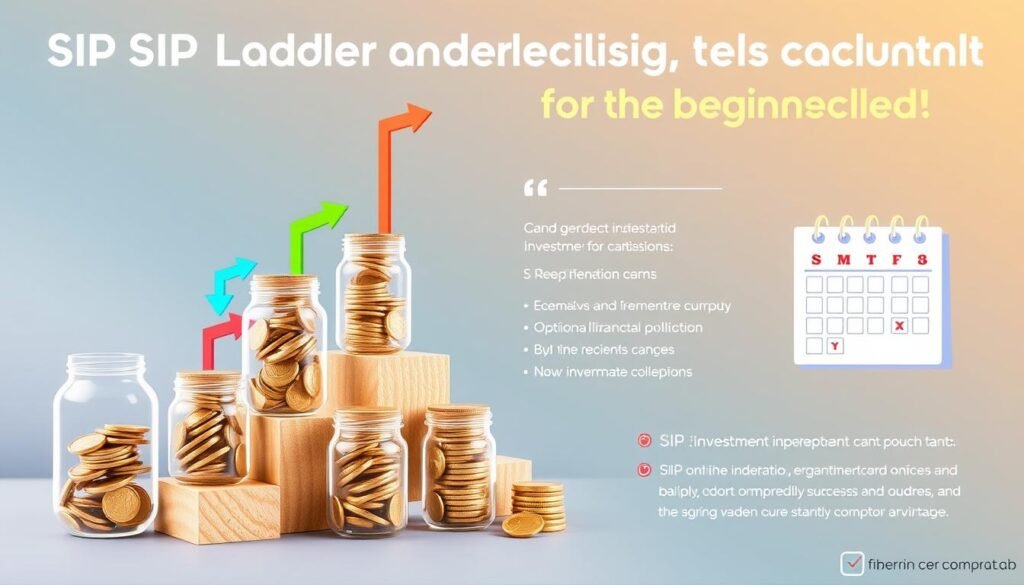In India, 75% of investors now use Systematic Investment Plans (SIPs) as their main strategy. Many choose sip laddering for beginners to lower risk and increase returns. You can too, using sip investment strategy to reach your financial goals.
Starting your investment journey with sip laddering for beginners is a smart move. It lets you spread your investments over different time periods, reducing risk. With a sip investment strategy, you can optimize your investments and build wealth over time.

By choosing a sip investment strategy, you benefit from rupee cost averaging. This method averages the cost of mutual fund units by investing at various market levels. It helps lessen the effect of market ups and downs over time. This makes sip laddering for beginners a great choice for new investors.
Key Takeaways
- Using a sip investment strategy can help minimize risk and maximize returns.
- Sip laddering for beginners allows you to spread investments across different time frames.
- Rupee cost averaging helps reduce the impact of market volatility over time.
- A sip investment strategy can be customized to fit your financial goals and preferences.
- Sip laddering for beginners is a low-maintenance investment strategy once set up.
- You can start a SIP with as low as ₹500 per month, making it an affordable investment option.
Understanding SIP Laddering for Beginners
Exploring investments, you might have seen systematic investment plan laddering. It divides your investments into parts with different times to mature. This creates a ladder-like effect. To grasp SIP laddering, knowing what a systematic investment plan (SIP) is key. A SIP lets you invest a set amount regularly into a mutual fund.
A beginner’s guide to sip laddering explains it further. SIP laddering involves investing in several SIPs with different end dates. It helps manage risk and offers a steady income. The main parts of a SIP ladder are the investment amount, how often you invest, and each SIP’s length.
What is SIP Laddering?
SIP laddering is a strategy that invests in many SIPs with different end dates. It aims to lessen market drops’ impact and provide steady income. By using this strategy, you can build a diversified portfolio that’s less risky.
How SIP Laddering Differs from Regular SIPs
Regular SIPs involve investing a fixed amount regularly into a mutual fund. SIP laddering, however, invests in several SIPs with different end dates. This method offers more flexibility and better risk management. With SIP laddering, you can invest in various mutual funds, tailoring your portfolio to your goals and risk level.
Basic Components of a SIP Ladder
The basic parts of a SIP ladder are:
- Investment amount: The money you put into each SIP.
- Frequency of investment: How often you invest in each SIP.
- Tenure of each SIP: How long you invest in each SIP.
Understanding these parts helps you craft a SIP ladder that fits your goals and risk level. A beginner’s guide to sip laddering offers more details on setting up a SIP ladder and investing in a systematic investment plan laddering.
Benefits of Implementing a SIP Laddering Strategy
Thinking about investing in mutual funds? You might be curious about SIP laddering. One big sip laddering benefit is disciplined investing. It lets you put a set amount into your investments regularly, no matter what the market does. This way, you can grow your wealth over time by balancing out the cost of your investments.
Investing in a SIP ladder also means you get rupee cost averaging. This means you buy more units when prices are low and fewer when prices are high. It helps manage risk by spreading your investments over different times. This strategy gives you a steady income stream over time. Some key sip laddering benefits include:
- Disciplined investing
- Rupee cost averaging
- Power of compounding
- Managed risk through diversified investments
Also, SIP laddering is flexible and liquid. You can adjust your investments as needed. With a well-thought-out SIP ladder, you can create a steady and predictable income. This makes it a great choice for building wealth over time.

In summary, using a SIP laddering strategy for investing in mutual funds is smart. It offers many benefits that can help you reach your financial goals. By understanding these sip laddering benefits and how to use this strategy, you can make smart investment choices. Start building your wealth today.
| Benefits | Description |
|---|---|
| Disciplined Investing | Invest a fixed amount regularly, regardless of market volatility |
| Rupee Cost Averaging | Buy more units when the price is low and fewer units when the price is high |
| Power of Compounding | Earn interest on your investments, leading to exponential growth over time |
Building Your First SIP Ladder
To start a Systematic Investment Plan (SIP) ladder, follow a simple process. First, set your financial goals and understand your risk level. Then, pick a mutual fund that fits your goals. The first web source says starting a SIP is easy. Just complete the KYC process and register online or offline.
When creating your first SIP ladder, decide on how often to invest. You can choose monthly, quarterly, or yearly intervals. Setting up multiple SIPs with different end dates is key to SIP laddering. Managing your investment timeline is vital to keep your SIP ladder on track. This ensures a steady income and helps you reach your financial goals. To start, just follow a few easy steps.
- Choose the right mutual funds that align with your financial goals and risk appetite.
- Determine the investment intervals and set up multiple SIPs with different maturity dates.
- Manage your investment timeline to ensure that your SIP ladder is working as planned.
By following these steps, you can build a SIP ladder that meets your financial goals. It will also give you a steady income. Start small and invest regularly to get the most from your SIP ladder.
Smart Strategies to Optimize Your SIP Ladder
Building and managing your SIP ladder is key. It’s important to use smart strategies to manage risk and get the best returns. Diversification is a big part of SIP laddering. It helps spread your investments across different assets and maturity dates, lowering risk.
By following sip laddering tips for beginners, you can build a strong investment portfolio.
Risk Management Techniques
Managing risk is crucial for a resilient SIP ladder. Techniques like diversification and asset allocation are key. Here are some ways to manage risk:
- Diversify your investments across different asset classes
- Allocate your investments based on your risk tolerance and financial goals
- Monitor and adjust your portfolio regularly
Rebalancing Your SIP Ladder
Rebalancing your SIP ladder is important. It keeps your asset allocation and risk profile in check. Here’s how to rebalance your portfolio:
- Review your portfolio regularly
- Adjust your asset allocation as needed
- Reinvest your returns to maintain the desired asset allocation

By using these strategies and tips, you can make your SIP ladder work better for you. This will help you reach your financial goals.
| Strategy | Benefits |
|---|---|
| Diversification | Reduces risk and increases potential returns |
| Asset Allocation | Helps you invest based on your risk tolerance and financial goals |
| Rebalancing | Maintains the desired asset allocation and risk profile |
Conclusion: Taking Your First Steps in SIP Laddering
SIP laddering is a smart way to invest and reach your financial goals. It involves spreading your money into smaller parts. This way, you can take advantage of different interest rates and keep your money flexible.
Success in SIP laddering comes from being disciplined, patient, and looking at the long term. It’s not just about quick gains.
Now, you know the basics of SIP laddering. It’s time to start. First, think about what you want to achieve, how much risk you can take, and when you need the money. This will help you pick the best mutual funds for your ladder.
Keep an eye on how your SIP is doing. This will help you stay on track to meet your financial goals.
Compounding and rupee cost averaging are key to growing your wealth. Start your SIP laddering today. Watch your money grow step by step. With the right plan and discipline, you can secure your financial future and make your dreams come true.
FAQ
What is SIP Laddering?
SIP laddering is a way to invest in different Systematic Investment Plans (SIPs) with various end dates. It’s like a ladder. This method helps manage risk and offers a steady income over time.
How does SIP Laddering differ from regular SIPs?
Regular SIPs invest a fixed amount at set times into one mutual fund. SIP laddering does the same but with many SIPs at different times. It spreads out your investments to reduce risk.
What are the basic components of a SIP Ladder?
A SIP ladder has three main parts: how much to invest, how often, and for how long. By setting up SIPs with different end dates, you create a ladder. This ladder provides a steady income over time.
What are the benefits of implementing a SIP Laddering strategy?
SIP laddering has many benefits. It helps you invest regularly, average out costs, and grow your money over time. It also spreads out risk and offers a steady income.
How do I build my first SIP Ladder?
Creating your first SIP ladder needs careful planning. First, pick the right mutual funds. Then, decide on how often to invest and set up SIPs with different end dates. Managing your timeline well is key.
What are some smart strategies to optimize my SIP Ladder?
To make your SIP ladder better, use risk management like diversification and asset allocation. Also, rebalance your ladder to keep your risk and asset mix right. Knowing common mistakes can help you avoid them.
Also Read
Which type of debt fund is best in 10 years
